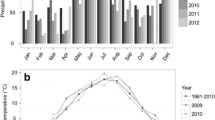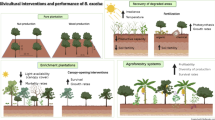Abstract
Reforestation of degraded land in tropical regions provides one means of restoring ecosystems and improving rural livelihoods. Most plantations in humid tropical regions are established in pure plots, including few species of high commercial value, generally exotics. The present study compares growth and economic viability of 15–16 year-old trees of native species in pure and mixed plantations on degraded pasturelands at La Selva Biological Station, Costa Rica. The species with the best growth were Vochysia guatemalensis, Virola koschnyi, Jacaranda copaia, Terminalia amazonia, and Hieronyma alchorneoides. The mixed plantations performed better than pure plantations for all growth variables considered, including height, diameter at breast height, volume, and aboveground biomass. Mixed plantations outperformed pure plantations economically, with Net Present Value (NPV) of $1,124 to $8,155/ha and Internal Rate of Return (IRR) of 7.7–15.6% depending on the species mixture. The most profitable pure plantations were those of Vochysia guatemalensis, with NPV and IRR of $6,035/ha and 14.3%, respectively; Hieronyma alchorneoides ($2,654 and 10.8%); and Virola koschnyi ($1,906/ha and 9.22%). These are the estimated benefits that would be accrued at harvest. These projections are realistic since the decision to harvest is generally mandated not just by profit maximization but by economic necessity, thus many small- to medium-scale farmers in Costa Rica harvest plantations prior to the completion of the rotation length. Mixed plantation may be the preferred system for reforestation with native species designed for timber production or carbon sequestration because this system is more economically viable and productive than pure plantations.


Similar content being viewed by others
References
Barrantes A, Salazar G (2008) Precios de referencia de la madera en Costa Rica, Oficina Nacional Forestal, September, 2008. http://www.oficinaforestalcr.org/media_files/download/Preciosdereferenciademadera2008.pdf
Bell T, Freckleton RP, Lewis OT (2006) Plant pathogens drive density-dependent seedling mortality in a tropical tree. Ecol Lett 9:569–574
Brown S (1997) Estimating biomass and biomass change of tropical forests: a primer. FAO Forestry Paper 134
Brown S, Lugo AE (1990) Tropical secondary forests. J Trop Ecol 6:1–32
Butler R, Montagnini F, Arroyo P (2008) Woody understory plant diversity in pure and mixed native tree plantations at La Selva Biological Station, Costa Rica. For Ecol Manage 255:2251–2263
Butterfield R (1996) Early species selection for tropical reforestation: a consideration of stability. For Ecol Manage 81:161–168
Butterfield R, Espinoza M (1995) Screening trial of 14 tropical hardwoods with an emphasis on species native to Costa Rica: fourth year results. New For 9:135–145
Chave JC, Muller-Landau HC, Baker TR, Easdale TA, ter Steege H, Webb CO (2006) Regional and phylogenetic variation of wood density across 2, 456 neotropical tree species. Ecol Appl 16:2356–2367
Chazdon R (2008) Beyond deforestation: restoring forests and ecosystem services on degraded lands. Science 320:1458–1460
Clark DA, Piper SC, Keeling CD, Clark DB (2003) Tropical rain forest tree growth and atmospheric carbon dynamics linked to interannual temperature variation during 1984–2000. Proc Natl Acad Sci USA 100:5852–5857
Craven D, Hall J, Verjans JM (2009) Impacts of herbicide application and mechanical cleanings on growth and mortality of two timber species in Saccharum spontaneum grasslands of the Panama Canal watershed. Rest Ecol. doi:10.1111/j.1526-100X.2008.00408.x
Cubbage F et al (2007) Timber investment returns for selected plantations and native forests in South America and the Southern United States. New Forests 33:237–255
Cusack D, Montagnini F (2004) The role of native species plantations in recovery of understory woody diversity in degraded pasturelands of Costa Rica. For Ecol Manage 188:1–15
Evans J, Turnbull J (2004) Plantation forestry in the tropics. The role, silviculture, and use of planted forests for industrial, social, environmental, and agroforestry purposes, 3rd edn. Oxford University Press, Great Britain, 467 pp
Ewel JJ, Mazzarino MJ (2008) Competition from below for light and nutrients shifts productivity among tropical species. PNAS 105:18836–18841
FAO (2001) Global forest resources assessment 2000. Main report. FAO Forestry Paper 140. Food and Agriculture Organization of the United Nations, Rome
FONAFIFO (2008) Montos asignados por hectáreas y/o arboles para el pago de los servicios ambientales por modalidad, Período 1997–2008
Futuro Forestal (2008) Primer pago de nuestras maderas. Woodstock News, Futuro Forestal Newsletter. El Dorado, Panama City, Panama
González E, Fisher R (1994) Growth of native species planted on abandoned pastureland in Costa Rica. For Ecol Manage 70:159–167
Haggar JP, Briscoe CB, Butterfield RP (1998) Native species: a resource for the diversification of forestry production in the lowland humid tropics. For Ecol Manage 106:195–203
Harvey CA, Komar O, Chazdon RL et al (2008) Integrating agricultural landscapes with biodiversity conservation in the Mesoamerican hotspot. Conserv Biol 22:8–15
Holdridge LR, Poveda LJ (1975) Árboles de Costa Rica. Centro Científico Tropical, Costa Rica, p 546
Jiménez Q, Poveda LJ (1997) Lista actualizada de los árboles maderables de Costa Rica. Aportes al Desarrollo Sostenible. Universidad Nacional, Heredia, p 36
Lam HS, Montagnini F, Finney C (2010) A comparison of growth and yield among four native and one exotic tree species in plantations on six farms at Las Lajas, Chiriqui Province, Western Panama. J Sustain For (in press)
Montagnini F (2001) Plantaciones forestales con especies nativas: una alternativa para la recuperación de áreas degradadas. Biocenosis 15:72–78
Montagnini F (2005) Plantaciones forestales con especies nativas. Una alternativa para la producción de madera y la provisión de servicios ambientales. Revista Recursos Naturales y Ambiente 43:26–33
Montagnini F, Mendelsohn RO (1997) Managing forest fallows: improving the economics of swidden agriculture. Ambio 26:118–123
Montagnini F, Sancho E, González E, Moulaert A (1993) Mixed-tree plantations with indigenous trees in the Atlantic lowlands of Costa Rica. In: Parrotta JA, Kanashiro M (eds) Management and rehabilitation of degraded lands and secondary forests in Amazonia. Proceedings of an international symposium. Santarem, Pará, Brazil. IITF-USDA-Forest Service, Puerto Rico, pp 161–169
Montagnini F, González E, Porras C et al (1994) Mixed-tree plantations in the humid tropics: growth, litterfall and economics of experimental systems in Latin America. IUFRO international symposium on growth and yield of tropical forests, Sept. 26-Oct. 1, 1994. Tokyo University of Agriculture and Technology, Tokyo, Japan, pp 125–135
Montagnini F, González E, Rheingans R, Porras C (1995) Mixed and pure forest plantations in the humid neotropics: a comparison of early growth, pest damage and establishment costs. Commonwealth For Rev 74:306–314
Montagnini F, Sancho F, González E, Porras C, Moulaert A, Monaco A (1997) Plantaciones forestales puras y mixtas con especies nativas para la reforestación de terrenos degradados en Costa Rica: estudio comparativo del crecimiento, daño por plagas, regeneración natural y costos de establecimiento. Biocenosis (Costa Rica) 12:25–34
Montagnini F, Ugalde L, Navarro C (2003) Growth characteristics of some native tree species used in silvopastoral systems in the humid lowlands of Costa Rica. Agrofor Syst 59:163–170
Montagnini F, Cusack D, Petit B, Kanninen M (2005) Environmental services of native tree plantations and agroforestry systems in Central America. J Sustain For 21:51–67
Montero M, Montagnini F (2005) Modelos alométricos para la estimación de biomasa de diez especies nativas en plantaciones en la región Atlántica de Costa Rica. Recursos Naturales y Ambiente 45:118–125
Muller-Landau HC (2004) Interspecific and inter-site variation in wood specific gravity of tropical trees. Biotropica 36:20–32
Nichols D (1994) T. amazonia (Gmel.) Exell.: development of native species for reforestation and agroforestry. Commonwealth For Rev 73:9–13
Nichols JD, Carpenter FL (2006) Interplanting Inga edulis yields nitrogen benefits to Terminalia amazonia. For Ecol Manag 233:344–351
Orozco Zamora C, Montagnini F (2007) Seed rain and seed dispersal agents in pure and mixed plantations of native trees and abandoned pastures at La Selva Biological Station, Costa Rica. Restor Ecol 15:453–461
Petit B, Montagnini F (2004) Growth equations and rotation ages of ten native tree species in mixed and pure plantations in the humid Neotropics. For Ecol Manage 199:243–257
Petit B, Montagnini F (2006) Growth in pure and mixed plantations of tree species used in reforesting rural areas of the humid region of Costa Rica, Central America. For Ecol Manage 233:338–343
Piotto D, Montagnini F, Ugalde L, Kanninen M (2003) Growth and effects of thinning of mixed and pure plantations with native trees in humid tropical Costa Rica. For Ecol Manage 177:427–439
Piotto D, Montagnini F, Kanninen M, Ugalde L, Víquez E (2004) Forest plantations in Costa Rica and Nicaragua: performance of species and preferences of farmers. J Sustain Forestry 18:59–77
R Development Core Team (2007) R: a language and environment for statistical computing. R Foundation for Statistical Computing, Vienna, Austria. http://www.R-project.org
Redondo-Brenes A (2007) Growth, carbon sequestration, and management of native tree plantations in humid regions of Costa Rica. New For 34:253–268
Redondo-Brenes A, Montagnini F (2006) Growth, productivity, aboveground biomass, and carbon sequestration of pure and mixed tree plantations in the Caribbean lowlands of Costa Rica. For Ecol Manage 232:168–178
Schroth G, Krauss U, Gasparotto L, Duarte Aguilar JA, Vohland K (2000) Pests and diseases in agroforestry systems of the humid tropics. Agrofor Syst 50:199–241
Sprugel DG (1983) Correcting for bias in log-transformed allometric equations. Ecology 64:209–210
Streed E, Nichols JD, Gallatin K (2006) A financial analysis of small-scale tropical reforestation with native species in Costa Rica. J For 104:276–282
Thacher T, Lee DR, Schelhas JW (1997) Farmer participation in reforestation incentive programs in Costa Rica. Agrofor Syst 35:269–289
Vanclay JK (2006) Experiment designs to evaluate inter- and intra-specific interactions in mixed plantations of forest trees. For Ecol Manage 233:366–374
Wishnie MH, Dent DH, Mariscal E et al (2007) Initial performance and reforestation potential of 24 tropical tree species planted across a precipitation gradient in the Republic of Panama. For Ecol Manage 243:39–49
Acknowledgments
This research was funded by the Program in Tropical Forestry of the Global Institute of Sustainable Forestry at Yale University, School of Forestry and Environmental Studies. We thank C. Salas, M. Otarola, and C. Finney for their generous assistance during the preparation of this manuscript.
Author information
Authors and Affiliations
Corresponding author
Rights and permissions
About this article
Cite this article
Piotto, D., Craven, D., Montagnini, F. et al. Silvicultural and economic aspects of pure and mixed native tree species plantations on degraded pasturelands in humid Costa Rica. New Forests 39, 369–385 (2010). https://doi.org/10.1007/s11056-009-9177-0
Received:
Accepted:
Published:
Issue Date:
DOI: https://doi.org/10.1007/s11056-009-9177-0




